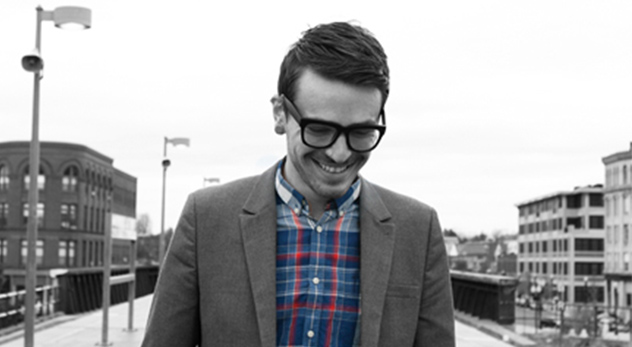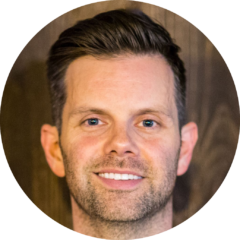
Chris Stedman, Assistant Humanist Chaplain at Harvard University, is sparking a conversation about Christian and atheist cooperation – photograph courtesy of Chris Stedman.
Christians and atheists are often seen as cultural and philosophical opponents. But can the two groups work together toward common goals? Chris Stedman, a 26-year-old interfaith activist, believes they can. And as an evangelical-Christian-turned-atheist, Stedman knows a little something about both communities.
Stedman serves as the Assistant Humanist Chaplain at Harvard University in Cambridge, Mass. and is author of Faitheist: How an Atheist Found Common Ground with the Religious. His book argues for the necessity of bridging the social gap between atheists and the religious so they can find common ground and work for the common good. Though Stedman’s message won’t resonate with everyone—may be particularly difficult for evangelicals who shy away from interfaith work—it is significant and worth exploring. Here we discuss Stedman’s ideas on how to break down the social divide between atheists and the religious.
JM: The title, Faitheist, is clearly an melding of the words “faith” and “atheist,” but how did you get there?
CS: Well, I didn’t invent the term “faitheist.” It’s one of several pejoratives used by some atheists to describe other atheists who are seen as too accommodating of religion or too friendly toward the religious—another one is the term “accommodationist.” I, and other atheists I know, have seen or heard these labels used to describe us and the work we’re doing to bring together atheists and religious believers for constructive conversation. In fact, the very first time I ever went to a meeting of atheists, someone called me a faitheist. I decided the term was ripe for reclaiming.
In that respect, being a faitheist means that I work to find common ground with people who have a different understanding of the world than I do. As a faitheist, I put “faith” in the idea that religious believers and atheists can and should identify common goals and work together to advance them. This doesn’t mean that I think religious (or nonreligious) ideas should be immune from criticism—we should be able to be honest and unapologetic about our disagreements. But I do think that atheists should be responsible, fair and accurate when offering criticisms of religious dogma, for both strategic and ethical reasons—and that we should invest more energy on working with religious communities than we do right now. That’s one of the reasons I wrote Faitheist, and why I decided to give it that name.
JM: Do you find that there is a social stigma towards atheism that characterizes atheists people as “bad people” whereas Christians would be considered the “do-gooders”? And if so, how do you think we break that mold?
CS: Absolutely. In fact, a number of studies have shown that atheists are among the least trusted, least respected groups in the United States. I often facilitate workshops at colleges and universities on atheism and religious diversity, and one of the first things I do is ask participants what words and phrases they hear people use when talking about atheists. Their responses are almost universally negative, and include words like “arrogant,” “angry,” “mean-spirited” and so on. When asked where these words come from, participants often point to a conflict-driven media that only highlights extreme perspectives, to the anti-atheist bias promoted by some religious figures and to the frequently anti-religious public and interpersonal representations of atheism.
Given the stereotypes that exist on both sides, I think that a different kind of dialogue is much needed. We can begin to break out of the stereotypes that some religious people hold about atheists, and that some atheists hold about religious people, by entering into conversation with people outside of our own communities and learning to look beyond the labels. Interfaith dialogue presents an opportunity for people to share their stories and values with one another—these stories and values humanize different communities to one another. If our communities remain distant, there aren’t opportunities to challenge the preconceived notions some people hold about other groups.
JM: At the age of 11, you became a born-again Christian, but now you consider yourself an atheist. What brought on that conversion?
CS: Looking back on it, there were two primary reasons I became a born-again Christian. About a year prior to my conversion, I started reading books like Roots, Hiroshima and The Diary of Anne Frank. These books not only increased my awareness of some of the greatest atrocities that have occurred throughout human history—they also told the story of the great suffering people had experienced. They filled me with empathy, with a desire for justice, with questions about meaning and purpose and suffering.
About a year later, when I was 11, my parents divorced. My sense of stability was suddenly disrupted, and I began looking for community and places to belong. Some friends—well, acquaintances—invited me to an after-school evangelical youth group. I went and was amazed that all social barriers seemed to evaporate; popular kids commingled with Geography Bee-nerds like me. I immediately felt welcomed and loved, and I was given answers to my questions about justice and suffering.
But the church I joined was also severely anti-gay, and I struggled with my sexual orientation for years before moving into LGBT-inclusive Christianity. Later, when I was studying religion in college and my Christian professors prompted me to reflect on my beliefs, I realized that my desire to be in community with others, to talk about values and to work toward creating a better world existed apart from the metaphysical commitments of Christianity, and that I had largely taken on those beliefs in conjunction with joining a Christian community. Today, being an atheist actually undergirds what I see as the ethical imperative to transcend religious differences and find interfaith understanding: if there are no divine forces that will intervene in human affairs, then it is up to us to improve the world.
JM: You have an unusual job title as a “humanist chaplain” at Harvard. Can you explain what it means?
CS: I’m the Assistant Humanist Chaplain at Harvard, where I coordinate a program called Values in Action, or VIA. VIA is our interfaith and community service program, which I started when I was brought on as the Humanist Community at Harvard’s Interfaith and Community Service Fellow a few years ago. In addition to my work as a Chaplain, where I help to organize the community of atheists, agnostics and the nonreligious at Harvard and am available for students who are looking for someone to talk to, my work on the VIA program is coordinating a series of events that bring together our community and religious communities for dialogue and service work. At least once a month, people from many different communities come together to combat systemic hunger, poverty and other important issues.
As one example: in the last year, we’ve brought together thousands of people to raise the funds for and then package 70,000 meals for food-insecure children in Massachusetts. Through working together, these people of all different beliefs and backgrounds are given an opportunity to learn from people who have a different perspective. The program is still relatively new, but we’ve been so heartened by how many people are interested in doing this kind of collaborative, relationship-building work.
JM: In Faithiest, you encourage atheists and Christians to come together and work for a greater good. How do you suggest we start building those kinds of relationships?
I think that one way to start building those relationships is by engaging in the kind of work I was just describing. That kind of coalition work not only increases the impact of any given community—by working with others, you can have a greater reach and a greater impact—it also creates a space where people are given an opportunity to meet and learn from people that they may see as not like them. I would encourage anyone interested in building interfaith bridges to reach out to others, to speak from your own experience, and, most importantly, to actively listen. Allow yourself to consider things that you haven’t; challenge yourself to empathize with ideas and experiences that seem alien and even scary. Be honest, but also be compassionate.
As a society, we frequently make these things harder than they need to be. People have so few opportunities to speak openly about religious differences in a way that feels welcoming, safe and constructively challenging. Fortunately, more and more people are working to create such spaces, which fills me with optimism for the future.





